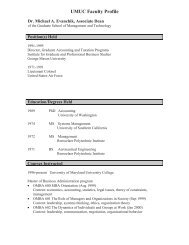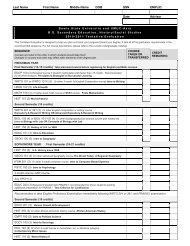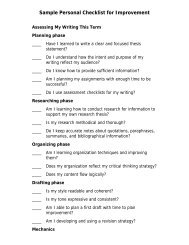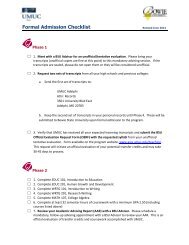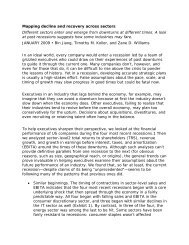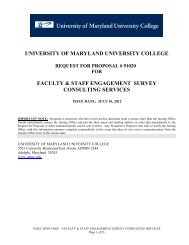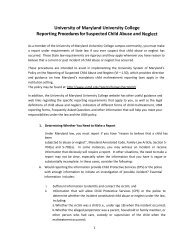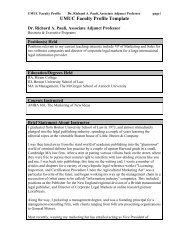1a. IntroSUS 2003 - University of Maryland University College
1a. IntroSUS 2003 - University of Maryland University College
1a. IntroSUS 2003 - University of Maryland University College
- No tags were found...
Create successful ePaper yourself
Turn your PDF publications into a flip-book with our unique Google optimized e-Paper software.
Statistics and ProbabilityCourses in statistics and probability (designated STAT) may beapplied as appropriate (according to individual program requirements)toward• a minor in mathematical sciences;• the statistics requirement for a variety <strong>of</strong> majors and minors; and• electives.A description <strong>of</strong> the curriculum for the mathematical sciencesminor begins on p. 76.STAT 200 Introduction to Statistics (3)Prerequisite: MATH 107. An introduction to statistics. Topicsinclude descriptive statistics, methods <strong>of</strong> sampling, tables, graphs,percentiles, concepts <strong>of</strong> probability, normal and chi-square distributions,sampling distributions, confidence intervals, hypothesistesting <strong>of</strong> one and two means, proportions, binomial experiments,sample size calculations, correlation, and regression. Applicationsin business, social sciences, and other fields are discussed. Studentswho receive credit for STAT 200 may not receive creditfor the following courses: BEHS 202, BEHS 302, BMGT 230,ECON 321, GNST 201, MATH 111, MGMT 316, PSYC 200,SOCY 201, or STAT 100.STAT 400 Applied Probability andStatistics I (3)Prerequisite: MATH 141. An intermediate study <strong>of</strong> statistical theory.Topics include random variables and standard distributions,sampling methods, law <strong>of</strong> large numbers and the central-limittheorem, moments, estimation <strong>of</strong> parameters, and testing <strong>of</strong>hypotheses.STAT 401 Applied Probability andStatistics II (3)(A continuation <strong>of</strong> STAT 400.) Prerequisite: STAT 400. Explication<strong>of</strong> more advanced statistical concepts. Topics include sufficientand consistent estimators, minimum variance and maximumlikelihood estimators, point estimation, and interval estimation.Applications include testing <strong>of</strong> hypotheses, regression correlationand analysis <strong>of</strong> variance, sampling distributions, sequential tests,and elements <strong>of</strong> nonparametric methods.STAT 410 Introduction to ProbabilityTheory (3)Prerequisites: MATH 240 and 241. A discussion <strong>of</strong> probabilityand its properties. Presentation covers random variables and distributionfunctions in one dimension and in several dimensions,as well as moments, characteristic functions, and limit theorems.STAT 450 Regression and VarianceAnalysis (3)Prerequisite: STAT 401 or STAT 420. A study <strong>of</strong> statistical techniques,concentrating on one-, two-, three-, and four-way layoutsin analysis <strong>of</strong> variance. Concepts and techniques presented includemultiple-regression analysis, the Gauss-Markov theorem, fixedeffectsmodels, linear regression in several variables, and experimentaldesigns.STAT 486A Internship in Statistics ThroughCo-op (3)Prerequisite: Formal admission to the Co-op program (programrequirements are listed on p. 18). An opportunity to combineacademic theory with new, career-related experience in statistics.At least 12 hours per week must be devoted to new tasks for aminimum <strong>of</strong> 180 hours during the Co-op session; four new tasksmust be delineated in the Learning Proposal; and the course requirementsmust be completed. May be repeated upon approval<strong>of</strong> a new Learning Proposal that demonstrates new tasks and objectivesrelated to statistics and that continues to advance application<strong>of</strong> academic theory in the workplace. Students may earn upto 15 semester hours in all internship coursework through Co-optoward a first bachelor’s degree and up to 9 semester hours towarda second bachelor’s degree. Co-op credits may not be used forgeneral education requirements and, unless otherwise specified,no more than 6 Co-op credits may be used in the academic majorand minor (combined).230





